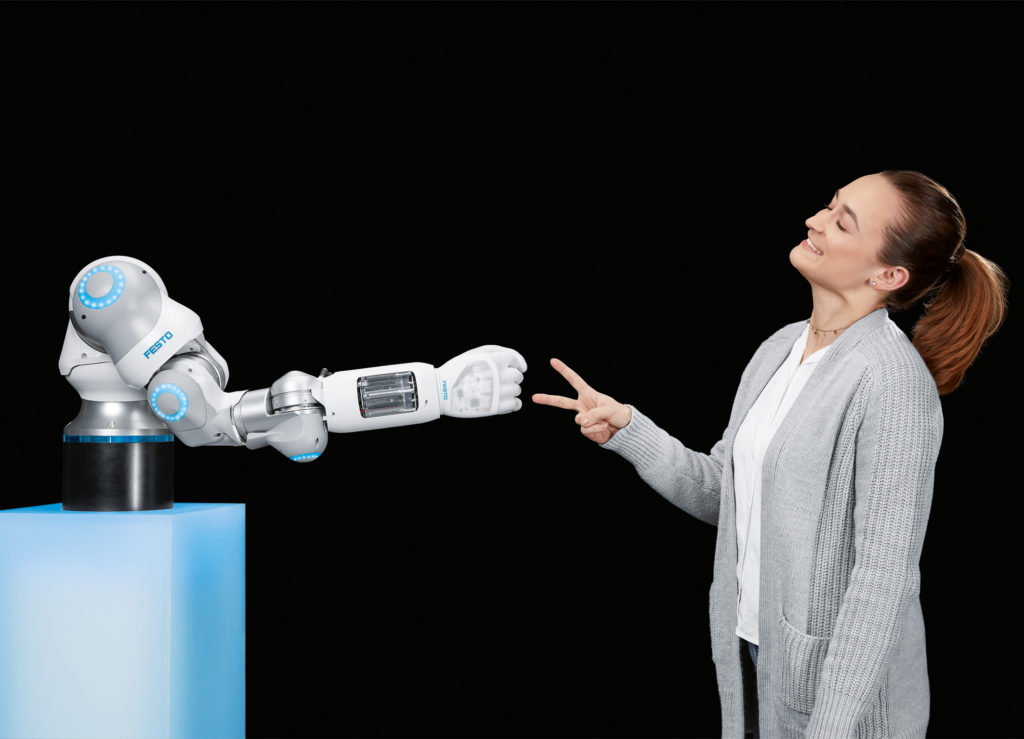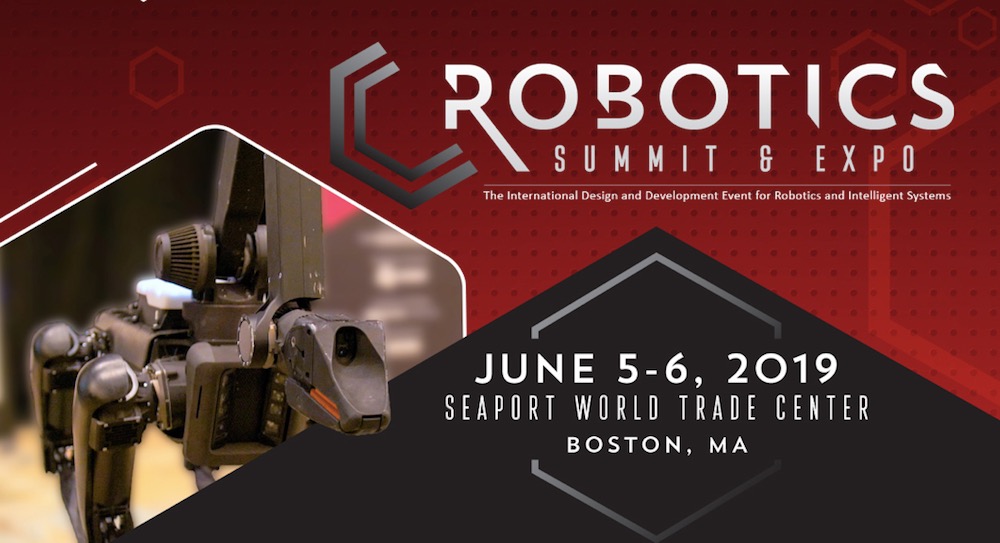2018年中国AGV机器人销量29600台 销售额达42.5亿元
2022年全球商用服务机器人市场规模将达到530亿美元
国家电网自主研发GIS/GIL智能带电检测机器人-国务院国有资产监督…
微软发布支持机器人应用的Windows Server IoT 2019
Festo’s Bionic robots merge pneumatics, artificial intelligence

Bionic SoftHand from Festo plays Rock-Paper-Scissors. Credit: Philipp Freudigmann
Whether it’s grabbing, holding or turning, touching, typing or pressing — in everyday life, we use our hands as a matter of course for the most diverse tasks. In that regard, the human hand, with its unique combination of power, dexterity, and fine motor skills, is a true miracle tool of nature. What could be more natural than equipping robots in collaborative workspaces with a gripper that is modeled after this example from nature and solves various tasks by learning with artificial intelligence? Festo’s Bionic series does just that.
Festo announced that it will show its BionicSoftHand pneumatic robot hand at Hannover Messe 2019. Combined with the BionicSoftArm, a pneumatic lightweight robot, these future concepts are suitable for human-robot collaboration.
The BionicSoftHand is pneumatically operated so that it can interact safely and directly with people. Unlike the human hand, the BionicSoftHand has no bones. Its fingers consist of flexible bellows structures with air chambers.
The bellows are enclosed in the fingers by a special 3D textile coat knitted from both, elastic, and high-strength threads. Thanks to this soft robotics material, it is possible to determine exactly where the structure expands and generates power and where it is prevented from expanding. This makes it light, flexible, adaptable, and sensitive, yet capable of exerting strong forces.
AI-guided Bionic grasping
The methods for machines to learn are comparable with those of humans. They require positive or negative feedback to their actions in order to classify and learn from them. BionicSoftHand uses this method of reinforcement learning.
This means instead of imitating a specific action, the hand is merely given a goal. It uses trial and error to achieve its goal. Based on received feedback, the Bionic gripper gradually optimizes its actions until the task is finally solved.
Specifically, the BionicSoftHand can rotate a 12-sided cube so that a previously defined side ends up on top. The necessary movement strategy is taught in a virtual environment with the aid of a digital twin, which is created with the help of data from a depth-sensing camera and computer vision algorithms.
Proportional piezo valves for precise control
To minimize the effects of tubing, Festo’s developers have specially designed a small, digitally controlled valve terminal, which is mounted directly on the BionicSoftHand. This means that the tubes for controlling the gripper fingers do not have to be pulled through the entire robot arm.
Thus, the BionicSoftHand can be quickly and easily connected and operated with only one tube each for supply air and exhaust air. With the proportional piezo valves used, the movements of the fingers can be precisely controlled.
The days of strict separation between factory workers and automation are passing, thanks to collaborative robots. As their workspaces converge, humans and machines will be able to work simultaneously on the same workpiece or component — without having to be shielded from each other for safety reasons.
The BionicSoftArm is a compact further development of Festo’s BionicMotionRobot, whose range of applications has been significantly expanded. Thanks to its modular design, the Bionic arm can be combined with up to seven pneumatic bellows segments and rotary drives. This guarantees maximum flexibility in terms of reach and mobility. The arm can work around obstacles even in the tightest of spaces if necessary.
At the same time, it is completely flexible and can work safely with people. Direct human-robot collaboration is possible with the BionicSoftArm, as well as its use in classic SCARA applications, such as pick-and-place tasks.
Flexible application possibilities
The modular robot arm can be used for a wide variety of applications, depending on the design and mounted gripper. Thanks to its flexible kinematics, the BionicSoftArm can interact directly and safely with humans.
At the same time, the kinematics make it easier for the Bionic arm to adapt to different tasks at various locations in production environments. The elimination of costly safety devices such as cages and light barriers shortens conversion times and thus enables flexible use – completely in accordance with adaptive and economical production.
BionicFinWave: Underwater robot with unique fin drive
Nature teaches us impressively, how optimal drive systems for certain swimming movements should look. To move forward, the marine planarian and sepia create a continuous wave with their fins, which advances along their entire length.
For the BionicFinWave, the bionics team was inspired by this undulating fin movement. The undulation pushes the water backwards, creating a forward thrust. This principle allows the BionicFinWave to maneuver forwards or backwards through an acrylic tube system.
The BionicFinWave’s two side fins are completely cast out of silicone and do not require struts or other supporting elements. The two fins are attached to the left and right of nine small lever arms, which in turn are powered by two servo motors. Two adjacent crankshafts transmit the force to the levers so that the two fins can be moved individually to generate different shaft patterns. They are particularly suitable for slow and precise locomotion and whirl up less water than, for example, a screw drive.
A cardan joint is located between each lever segment to ensure that the Bionic robot’s crankshafts are flexible. For this purpose, the crankshafts including the joints and the connecting rod are made of plastic in one piece using the 3D printing process.
Intelligent interaction of a wide variety of components
The remaining elements in the BionicFinWave’s body are also 3D-printed, which enables its complex geometries in the first place. With their cavities, they act as flotation units.
At the same time, the entire control and regulation technology are watertight, safely installed and synchronized in a very tight space. The Festo Bionic Learning Network has continued its innovative approach to robotics.
The post Festo’s Bionic robots merge pneumatics, artificial intelligence appeared first on The Robot Report.
AI机器人在微博搜寻自杀者:高风险用户预警准确率达82%
山东建人工智能研究院 聚焦“5G+人工智能”研发
US robot shipments break record despite automotive decline
 Keynotes | Speakers | Exhibitors | Register
Keynotes | Speakers | Exhibitors | Register
Companies in North America installed robots at a record pace in 2018, according the the Robotic Industries Association (RIA). The 35,880 units shipped in 2018 marked a 7 percent increase from 2017. And is the United States, specifically, robot shipments increased 15% to a record 28,478.
Most areas showed growth in robot shipments, including food and consumer goods (48%), plastics and rubber (37%), life sciences (31%), and electronics (22%). Overall robot shipments to non-automotive companies increased 41 percent to a record 16,702 units.
The only sector analyzed by the RIA that slowed was automotive, which dropped 12 percent to 19,178 units shipped in North America from the 21,732 units shipped in 2017. The automotive industry still accounted for 53 percent of total robot shipments in North America in 2018. But that is the lowest percentage share since 2010.
And many signs are pointing to a downshift in automotive sales, so automotive could continue to see a decline in overall robot shipments. After three straights years of growth – a record 17.6 million units were sold in 2016 – sales of new vehicles in the US have started to slide. The US is the second-largest automotive market in the world.
China, the world’s largest car market, saw annual automotive sales dip for the first time in nearly two decades in 2018. Auto sales in China fell 3 percent in 2018, but analysts don’t see things improving going forward. Automakers sold about 28 million vehicles in China in 2018.

Source: Axios
“While the automotive industry has always led the way in implementing robotics here in North America, we are quite pleased to see other industries continuing to realize the benefits of automation,” Jeff Burnstein, President of the Association for Advancing Automation (A3) said. “And as we’ve heard from our members and at shows such as Automate, these sales and shipments aren’t just to large, multinational companies anymore. Small and medium-sized companies are using robots to solve real-world challenges, which is helping them be more competitive on a global scale.”
While the US installed more robots than ever, it still has a ways to go it in terms of being the most automated country in the world. That title belongs to the Republic of Korea, according to the latest robot density numbers from the International Federation of Robotics (IFR) that measures the number of robots per 10,000 workers in an industry. The Republic of Korea, also known as South Korea, had a robot density of 631, which was eight-times more than the global average.
The US ranked seventh, according to the IFR’s analysis, with a robot density of 189 in 2016. The main drivers of growth were the “Made in the US” and re-shoring initiatives.

Countries with the most automation in manufacturing industries. (Credit: International Federation of Robotics)
The post US robot shipments break record despite automotive decline appeared first on The Robot Report.